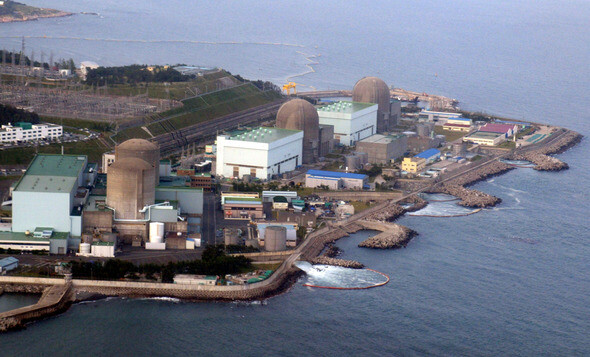hankyoreh
Links to other country sites 다른 나라 사이트 링크
[Editorial] It’s scary when a nuclear plant can’t even handle a rainstorm

The second reactor at Kori Nuclear Power Plant in Gijang County, Busan, was temporarily shut down by Korea Hydro and Nuclear Power (KHNP) on Aug. 25 after heavy rains of up to 130 millimeters per hour in the area. Meanwhile, electrical equipment at KHNP’s Kori headquarters, which are supposed to oversee on-site emergency response measures, was incapacitated for a second straight day by the flooding. A nuclear power plant is supposed to be able to withstand any and all types of shocks from the outside. To see this kind of vulnerability to a rainstorm is spine-chilling.
This is the first time in South Korean history that a nuclear power plant has been shut down because of heavy rainfall. According to KHNP, the second Kori reactor was shut down manually as a precaution for equipment safety after too much water got into the building housing the seawater pumps and control devices. They’re suggesting it was a preemptive response for safety purposes. They also plan to restart the reactor once they’ve removed the water, conducted a safety examination, and received the go-ahead from the Nuclear Safety and Security Commission (NSSC).
But this accident is not something we can just ignore. The second Kori reactor, which marks its 32nd year in operation this year, is a prime example of an outdated nuclear power source. It’s already been pointed out numerous times how sloppy the protective measures for this reactor are, even as it’s being run past the end of its original design life. Experts are particularly troubled that the cause of the shutdown was water intake system flooding - since it was similar flooding, as a result of a tsunami, that ended up being the direct cause of the 2011 Fukushima catastrophe in Japan.
In a nuclear power plant, a water intake system needs to be constantly supplying seawater to cool the steam that makes the turbine run. The most dangerous moments are the ones where the reactor has to be shut down because of some unforeseen disaster or internal equipment failure, and the chances of something like that happening increase the older the equipment is - and the equipment at Kori is nothing if not old. Not only that, but an unexpected stoppage of even one reactor at a major power supply center like a nuclear plant can deal a major blow to power grid function all over the country.
Since the Fukushima disaster, the South Korean government and KNHP have publicly pledged to beef up the natural disaster capabilities of nuclear power plants. One of the examples they proudly presented as safer against various disasters, thanks to stronger waterproofing in its walls, was none other than the second Kori reactor. The recent flooding and shutdown expose their boasting for the bluster it was.
When a nuclear power plant with over 3 million people living in a 30-km radius can’t handle heavy rains - never mind the various larger and smaller other incidents - the public has a right to feel scared. The analysis of the extent and cause of the recent damage should be investigated by the NSSC itself, rather than being given to KNHP to examine. A joint civilian-government investigation should also be considered as a way of ensuring complete safety and keeping the public’s trust.
Please direct questions or comments to [english@hani.co.kr]

Editorial・opinion
![[Column] Has Korea, too, crossed the Rubicon on China? [Column] Has Korea, too, crossed the Rubicon on China?](https://flexible.img.hani.co.kr/flexible/normal/500/300/imgdb/original/2024/0419/9317135153409185.jpg) [Column] Has Korea, too, crossed the Rubicon on China?
[Column] Has Korea, too, crossed the Rubicon on China?![[Correspondent’s column] In Japan’s alliance with US, echoes of its past alliances with UK [Correspondent’s column] In Japan’s alliance with US, echoes of its past alliances with UK](https://flexible.img.hani.co.kr/flexible/normal/500/300/imgdb/original/2024/0419/2317135166563519.jpg) [Correspondent’s column] In Japan’s alliance with US, echoes of its past alliances with UK
[Correspondent’s column] In Japan’s alliance with US, echoes of its past alliances with UK- [Editorial] Does Yoon think the Korean public is wrong?
- [Editorial] As it bolsters its alliance with US, Japan must be accountable for past
- [Guest essay] Amending the Constitution is Yoon’s key to leaving office in public’s good graces
- [Editorial] 10 years on, lessons of Sewol tragedy must never be forgotten
- [Column] A death blow to Korea’s prosecutor politics
- [Correspondent’s column] The US and the end of Japanese pacifism
- [Guest essay] How Korea turned its trainee doctors into monsters
- [Guest essay] As someone who helped forge Seoul-Moscow ties, their status today troubles me
Most viewed articles
- 1[Column] The clock is ticking for Korea’s first lady
- 2[Correspondent’s column] In Japan’s alliance with US, echoes of its past alliances with UK
- 3After 2 months of delayed, denied medical care, Koreans worry worst may be yet to come
- 4[Column] Has Korea, too, crossed the Rubicon on China?
- 5[Editorial] When the choice is kids or career, Korea will never overcome birth rate woes
- 6Samsung barricades office as unionized workers strike for better conditions
- 7US exploring options for monitoring N. Korean sanctions beyond UN, says envoy
- 8US overtakes China as Korea’s top export market, prompting trade sanction jitters
- 9[Photo] Smile ambassador, you’re on camera
- 10Hong Se-hwa, voice for tolerance whose memoir of exile touched a chord, dies at 76